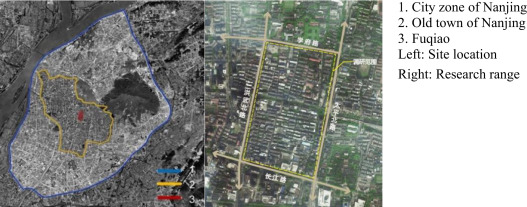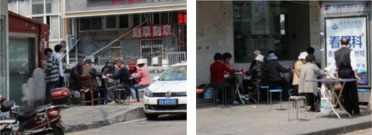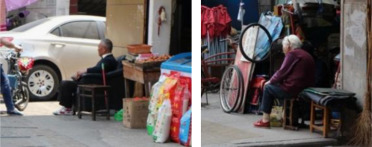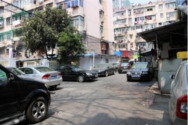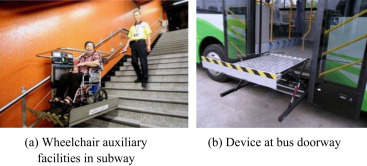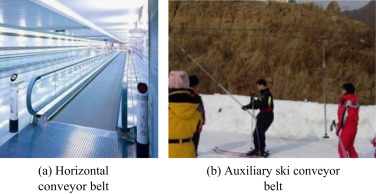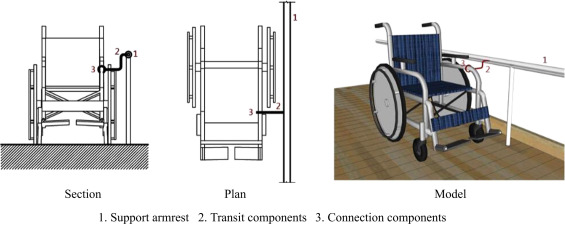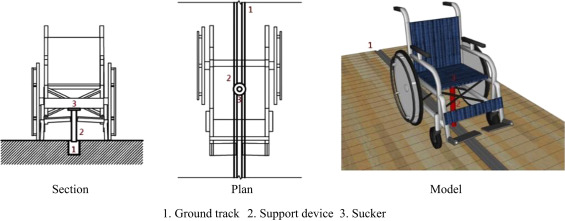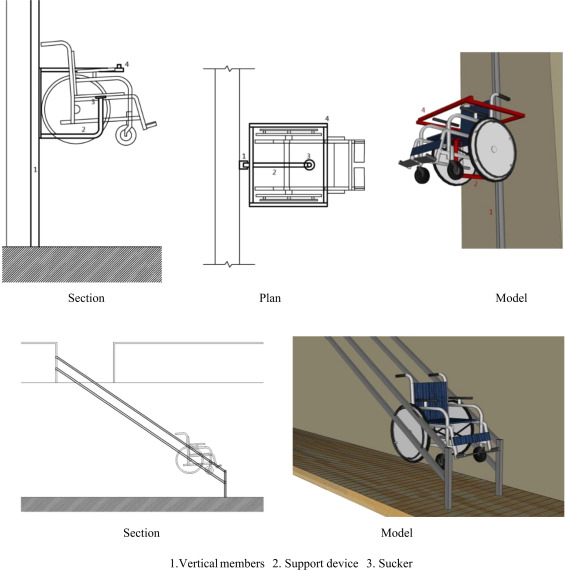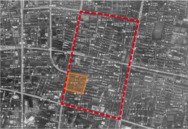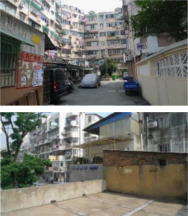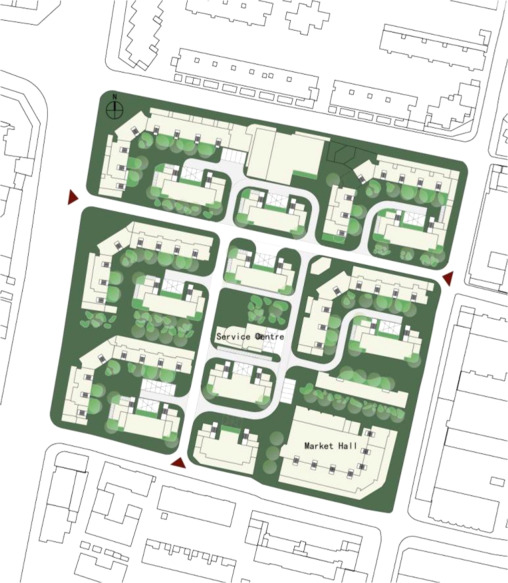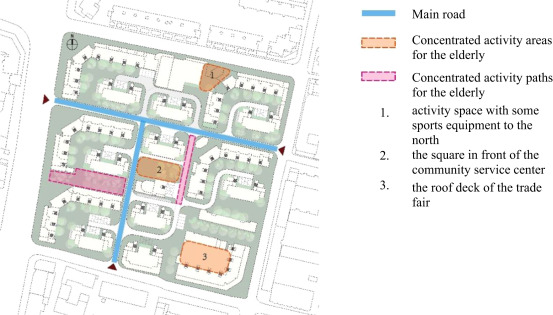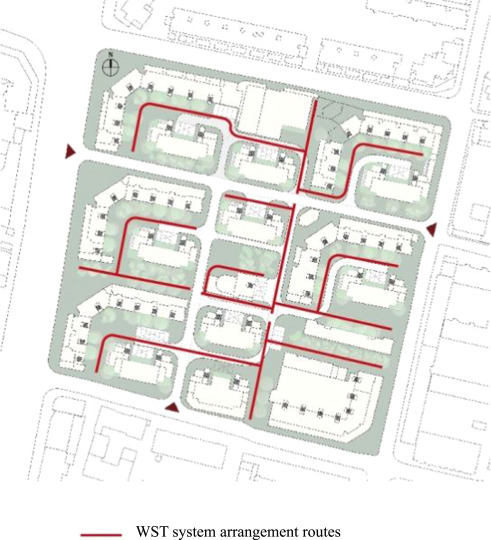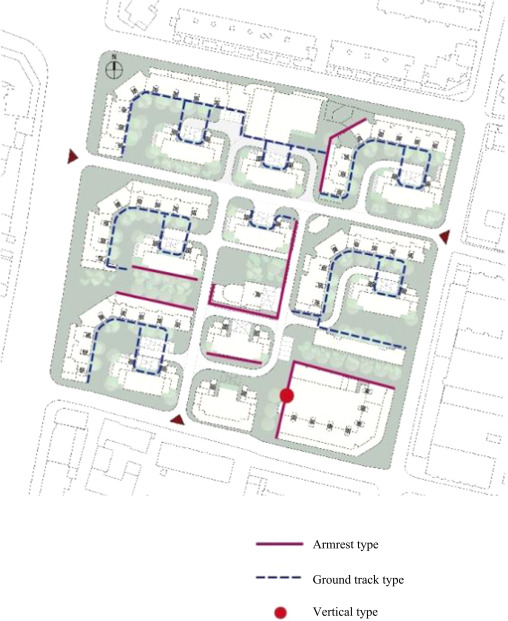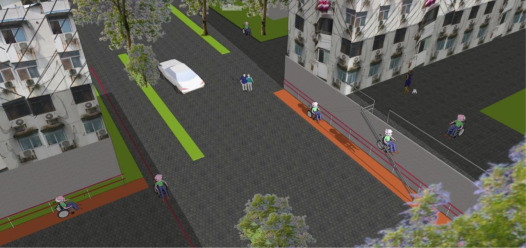Abstract
Based on research of the current situation and analysis result of a case study in the Nanjing region, this paper proposes a “wheelchair slow transit”(WST) system-based elderly auxiliary travel mode. The system involves three fundamental composition frames, namely, support, transit components, and connection components. Each component is designed as an armrest, ground track, or vertical type to respond to actual demands. Thus, this system may be adaptable to diverse conditions. Taking Xiangpuying community as a case study, the author examined the application of the WST auxiliary mode in particular communities. The WST system helps to increase the accessibility of existing public areas, creates a safe community traffic environment, improves municipal facilities, and strengthens universal design. The study intends to provide a reference to obtain a complete aged care design and to build a comfortable and livable aged care community environment.
Keywords
The elderly ; Auxiliary travel mode ; “Wheelchair slow transit” system
1. Introduction
The rapid growth of the aging population has become a global problem in the twenty-first century. The current number of the elderly over 65 years old worldwide has already exceeded 342 million, and this value is expected to double by the year 2020 at 722 million (Fujiwara et al ., 2000 ; Murayama et al ., 2012 ). The number of senior citizens has increased with improved medical conditions and life quality, especially in developed countries (Courtney et al ., 1997 ; Mullan and Budger, 2007 ; Nachreiner et al ., 2007 ).
Currently, among the 1.36 billion people in China, the elderly population aged more than 60 years old reached 194 million in 2014 and will increase continuously in the future. The elderly population of China is the largest in the world and has an extraordinarily rapid growth rate. From 2001–2020 and 2021–2050, China׳s aging population is expected to grow at a rate of 5.96 and 6.2 million/year, respectively. By 2050, the elderly population will reach 400 million, which accounts for 30% of the total population (China Municipal Committee for Aging People, 2011 ; Kinsella and Wan, 2009 ; O׳Neil et al ., 2010 ). Thus, care for the elderly has become a great challenge in China.
As society shows increasing concern about the issue of aged care, several countermeasures that aim to enhance aged care environment have been developed recently. Among these countermeasures, studies on aged care strategy at the urban community level have the most significant effect on improving the daily life environment quality of the aged population. In a number of newly-built aged care communities, auxiliary facilities and barrier-free access are designed for the elderly in public buildings, traffic roads, and outdoor environment. However, in the majority of the existing communities, poorly designed infrastructures result in considerable inconvenience to the daily life of the elderly. Thus, to address the issue of aged care, this paper discusses practical problems and solutions concerning the daily lives of senior citizens.
2. Survey on the current travel situation of the elderly
To determine the real-life status and travel demand of the elderly, a field study was conducted in Fuqiao, Nanjing. Fuqiao is located in the old city of Nanjing and is composed of numerous old communities. Unlike new communities, the old communities are largely inhabited by senior citizens.
Fuqiao has a total area of 600,000 m2 and is bounded by Xuefu Road, Changjiang Road, Hongwu North Road, and Taiping North Road. Fuqiao accommodates 36 communities, most of which were built before the 1990s. They are relatively shabby and are occupied by a large number of senior citizens. This study focuses on the present situation of the community environment, the daily activity content of the elderly, and their travel modes (Figure 1 ).
|
|
|
Figure 1. Research area. Source : Google Maps and drawn by the author. |
2.1. Daily travel modes of the elderly
Physically healthy senior citizens tend to walk for a relatively short distance or carry foldable stools to enable them to rest during long-distance walking. Disabled senior citizens depend on auxiliary facilities for activity, and the use of wheelchairs is currently the most popular option. The number of elderly people aged 60 years old and above will reach 1.31 million by 2015, with disabled elders accounting for 89,500,1 which is as high as seven percent of the total elderly population. Thus, a considerable number of old people need wheelchairs to perform daily tasks. Given that all aged people climb ladders, virtually all elderly will eventually have to rely on wheelchairs, in whole or in part, as their physical strength declines gradually. Thus, traveling via wheelchair is a common daily travel mode for senior citizens.
2.2. Independent travel demand of the elderly
Studies have shown that street corners of communities, civil squares by the river, and public parks are popular venues in which the elderly perform social activities (Figure 2 ). The elderly generally maintain excellent body conditions and are fond of such activities. Moreover, many aged people just sit by door steps to rest and bask in the sun (Figure 3 ). Most of these elderly are poor, and several are disabled and in dire need of wheelchairs. During an interview, they expressed their passion for outdoor activities, but also mention difficulty in getting around the confines of their activity areas.
|
|
|
Figure 2. Elderly activities. |
|
|
|
Figure 3. Elderly at the doorstep. |
In cities nowadays, children commonly work in distant locations, and an increasing number of aged parents are faced with the plight of an independent life. Outdoor activities are indispensable to senior citizens because they need to bask in the sun and must be exposed to fresh air to keep themselves fit through regular outdoor exercises. Their life demands can be satisfied through daily shopping, hanging out, and receiving medical advice, social identity, and psychological security through specific social activities. This finding shows that the elderly have a strong desire for independent travel. However, the travel activities of many disabled elders nowadays are limited because of poor health conditions.
2.3. Problems of wheelchair travel
As an auxiliary facility, the wheelchair is widely accepted by the aged group. However, its use gives rise to several problems.
- Inconvenient operation: the wheelchair is operated through wheel rotation driven by arm power. Thus, using a wheelchair is laborious for the elderly, and they require aid during long-distance travel. As a result, traveling alone over a long distance can be difficult for old wheelchair users.
- Rough ground circulation: residential buildings of the 1980s and 1990s largely adopt a slab-type design, in which each building׳s shape is long and the outdoor environment is divided into discontinuous long strips. As a result, the community layout has a relatively long route, which decreases the convenience of moving about inside the community (Figure 4 ). Even public space in a community with a short straight-line distance may be in accessible to elderly wheelchair users because of the zigzag layout of the route.
|
|
|
Figure 4. Circulations of communities. |
- Inaccessible elevation difference in travel path: the use of a wheelchair is demanding even if the road surface is smooth because differences in step elevation may hamper wheelchair access. In existing old communities, not all places with elevation difference are equipped with a ramp design to allow direct wheelchair access. Moreover, although several activity spaces built on high-rise platforms of buildings offer ample space, privacy, and security, these spaces have a very low utilization rate among the elderly because of their inaccessible height.
- Poor traffic safety: a wheelchair path is seldom considered because of relatively narrow and simple-designed roads inside and around the old communities. Moreover, the poor carrying capacity caused by the recent surge of private cars results in traffic jams, conflict between pedestrians and vehicles, occupation of considerable ground space, and influence on normal traffic by parking. Traffic chaos and poor traffic safety discourage elderly wheelchair users from going outside alone (Figure 5 ).
|
|
|
Figure 5. Traffic chaos in the community. |
2.4. Survey conclusions
The following conclusions are drawn from the above survey and study:
- Wheelchair travel is the most popular daily travel mode among the elderly.
- The elderly have a strong desire for independent travel, but the travel activities of many disabled elders are limited because of their poor health conditions.
- During actual travel application, the use of wheelchairs is faced with several problems, such as inconvenient operation, rough ground circulation, inaccessible elevation difference in travel path, and poor traffic safety.
Thus, given that the existing auxiliary facilities and community space environment fail to cater to the daily life demands of the elderly and that independent travel of the elderly seems to be more convenient, a new auxiliary mode to improve the independent travel feasibility of the elderly and optimization of the environment of outdoor activities are necessary.
3. Auxiliary travel mode for the elderly: “Wheelchair slow transit” system
To address the travel difficulties of the aged caused by inconvenient operation of auxiliary facilities, poorly inaccessible public spaces, and potential traffic dangers, this paper proposes the design of a wheelchair slow transit (WST) system to serve as an auxiliary travel mode.
The system׳s technical measures mainly address the inconvenient operation of wheelchairs. The function of the system on facilitating public activity space and quality are discussed below through specific cases.
3.1. Design reference
Systematic auxiliary facilities for the aged are not yet available at present. The design takes cues from valuable references and inspirations from other applicable auxiliary facilities.
Local wheelchair auxiliary facilities have functioned well in particular occasions. In a subway station, wheelchairs can move up and down a flight of stairs by fixing one end of the stair lift to the stair railing and by using the other end as the support plate for wheelchairs. The support plate may be folded when unnecessary to save traffic space. At a transit bus entrance, wheelchairs can be loaded through the mobile plate. Both cases use handy devices to address wheelchair movement. Thus, these cases can be used as references for the design of the WST system (Figure 6 ).
|
|
|
Figure 6. Existing wheelchair auxiliary facilities. |
Coincidentally, several auxiliary facilities that serving the general public have reference value for this research. Horizontal conveyor belts that facilitate human movement in many public places, such as airports and scenic spots, are smooth and comfortable. However, they are costly to construct, large, and monotonous in form. Auxiliary conveyor belts in ski resorts enable human movement through friction between the snow and the sleigh and tensile force of the belt. However, the use of these belts requires physical strength and skills because of their poor stability (Figure 7 ). Traction and support approaches against wheelchairs and facilitation of human movement through conveyors in existing auxiliary facilities provide bases for the establishment of a new auxiliary mode.
|
|
|
Figure 7. Daily auxiliary facilities. |
3.2. Conceptual design of WST system
The WST system is composed of three parts, namely, support, transit components, and connection components. The support holds up the entire transit system, the transit components propel wheelchair movement as moving elements, and the connection components support the wheelchairs and link the wheelchair parts with the transit components. The slow movement rate of the system at 3 kph is consistent with the adaptive movement speed of elderly people, which makes the system suitable for the elderly.
Moreover, the system will not occupy too much outdoor space and has improved adaptation to practical conditions with its diverse environmental need-oriented types. The paper attempts to design three WST types for different environmental conditions; these designs are the armrest, ground track, and vertical types.
- Armrest type
This type utilizes portable armrests as transit components of wheelchairs with the connection components resting on the sides. During operation, the wheelchair is moved to its proper position adjacent to the system. The wheelchair is then connected with the hook, which mobilizes the wheelchairs at a constant speed with the slow movement of the transit armrest. Disconnecting the hook will free the wheelchair again (Figure 8 ).
|
|
|
Figure 8. Armrest design. |
The armrest type is easily implemented because it has a relatively simple form and affordable production costs. However, it is unsuitable for places with overwhelming traveling circulation tracks or somewhat open places because armrests block the circulation track. Suitable environmental types involve sites with existing armrests or building exterior walls or potential environments that require arrangement of the elements in combination with the new system.
- Ground track type
This type places the main transit equipment underground only with the connection sucker exposed. The sucker can sense when the wheelchair moves on it, attaches to the wheelchair׳s bottom, and mobilizes the wheelchair along an embedded ground track circulation track (Figure 9 ).
|
|
|
Figure 9. Ground tack design. |
The design has virtually no effect on ground activities and has strong adaptability to the environment because it minimizes the use of ground equipment. However, it is more expensive to construct than the armrest type. Suitable environmental types include all flat ground spaces.
- Vertical type
This type utilizes vertical support components to manipulate movement direction, and the bottom sucker is used as the main support connection component. To improve stability, two one-sided system support and increased support points are applied to meet safety and stability requirements during vertical transit. When crossing steps, the vertical support components align themselves with the slope to enable the wheelchair׳s trailing movement. When vertical transit is the only option in places with significant elevation difference and limited environment space, retaining armrests can be added around the wheelchair to lessen the emotional insecurity of the aged during vertical movement (Figure 10 ). Suitable environmental types include places with steps or significant elevation difference.
|
|
|
Figure 10. Vertical design. |
3.3. Function of WST system on travel of the elderly
The design of the WST system aims to establish a versatile facility system based on a simple principle. The design includes three fundamental composition frames, namely, support, transit components, and connection components. Given that the real forms of each component are more abundant in response to actual demands, this system may be more adaptable to the environment and is more feasible.
The benefits of the WST system to the elderly are as follows: the aged may be free from the constraints of outdoor activity caused by elderly mobility; the possibility of independently operating wheelchairs by the aged is greatly enhanced because labor-consuming and inconvenient operation are considerably eliminated by the system׳s slow speed, high comfort, and convenient connection among components; the pressure on the family to care for their elderly is eased; and the desire for positive and independent living of the aged is realized.
4. Application of WST auxiliary mode: A case study of Xiangpuying community
4.1. Current situation of the community
The Xiangpuying community in Fuqiao was selected to study the application of the WST system. Located to the southwest of Zhenxiang and built in the 1980s, the community, with a total area of 37,000 m2 , was a high-grade residential area. However, the past 20 years saw the aging of most household members, outmoded community facilities, and limited space environment. The application of the WST system in the community aims to improve the travel convenience of the aged residents and increase the number of community activities (Figure 11 , Figure 12 ; Figure 13 ).
|
|
|
Figure 11. Community location. |
|
|
|
Figure 12. Xiangpuying live-action. |
|
|
|
Figure 13. General plan. |
As seen in the general plan, the community has five building clusters and four detached houses. Without any auxiliary travel facility, a 300 m walk from the farthest house to the community entrance is required. Thus, the activities of disabled people are confined to the clusters.
As the main traffic road, the T-type road that connects all entrances of the community serves as the main driveway and is thus an unsafe activity region for the elderly. A total of three concentrated activity sites are available to the elderly in the community, namely, an activity space with sports equipment to the north, the square in front of the community service center, and the roof deck of the trade fair; this deck is spacious, yet its use is limited because of its poor accessibility. Two paths house the other activities in the community. One path has a bulletin board outside the eastern wall of the service center, and the other path has lush vegetation and ensures privacy between two building clusters to the southwest (Figure 14 ).
|
|
|
Figure 14. Current situation analysis of the community. |
4.2. Planning and application of the WST auxiliary mode in the community
The path planning principles of the WST system are as follows: first, the most convenient circulation shall be maximized to link public sites and paths with high activity frequency. Second, the system shall be available to each building to equalize system convenience among the elderly. Third, the new system circulation shall attempt to give way to original vehicle circulation to promote system operation safety.
Based on assembly locations and activity paths favored by the elderly in the Xiangpuying community, the application of the WST system involves the selection of the roads to the east and south of the community as main routes. These roads are associated with the main activity areas of the aged and are separated from the motor traffic because the main driveways to the north and west are avoided. Upon confirming the main circulation direction, the WST system then links each cluster to make it resident friendly. Thus, a complete traffic system through the WST system is formed in the community (Figure 15 ).
|
|
|
Figure 15. WST system location. |
The three specific system types may be applied to corresponding locations based on the practical conditions of the community. The armrest design shall be mainly used at buildings with elevated back platforms and outside the compound wall. In these areas, armrest installation will be facilitated by integrating existing vertical component supports. The ground track design shall be mainly arranged at building entrances and places with high people flow and where normal traffic will not be affected. The vertical design shall be applied to the link between the roof deck of the trade fair at the southeast corner of the community and the ground in an attempt to improve the vitality of the roof deck. In this manner, the setting of diverse WST equipment in the Xiangpuying community can fully cater to the demands of the existing environment (Figure 16 ; Figure 17 ).
|
|
|
Figure 16. Application of three WTS system designs. |
|
|
|
Figure 17. Expected actual community scene with WST system. |
4.3. Positive functions of the WST auxiliary mode on community environment creation
The establishment of the WST system in the Xiangpuying community helps to enhance the convenience and quality of public activity space in the following ways:
- The system contributes to improving the accessibility of the community׳s existing public activity space as well as the link between these public areas. The vitality of public sites that are rarely used, such as the square in front of the community service center and the roof deck of the food market, may be developed to fully serve the aged.
- Given that it is separated from the original traffic system, the WST system is devoted to fully enhance the community traffic potential and to construct a more complete and rational traffic network. A safe community traffic environment is created by separating people, vehicles, and the crowd to mitigate road conflicts.
- Incorporating the WST system into municipal facilities to serve in communities or in other communities can forma complete auxiliary system in an extended range to enhance regional elderly auxiliary facilities.
- As a universal design, the WST system may serve both the aged and the disabled who are wheelchair-bound in daily life.
5. Conclusions and prospects
Based on the above survey and study, the following conclusions were drawn:
- In response to problems faced by the aged during independent wheelchair travel, such as inconvenient operation, rough ground circulation, inaccessible elevation difference in travel path, and poor traffic safety, this paper proposes the establishment of a new auxiliary mode to facilitate elderly independent travel and to optimize the outdoor activity environment of the aged.
- This paper details the elderly-oriented auxiliary mode through a conceptual design of the WST system, which is composed of three fundamental composition frames, namely, support, transit components, and connection components. Each component is designed as armrest, ground track, or vertical type in response to actual demands. Thus, the system may be adaptable to diverse environments. The establishment of the WST system frees the aged from the constraints to outdoor activity and enhances elderly mobility by considerably eliminating the labor-consuming and inconvenient operation of wheelchairs.
- This paper chose the Xiangpuying community as a case study and probes into the application of the WST auxiliary mode in the community. The system aims to link the main elderly activity spaces and avoids main driveways by relying on the community׳s existing environment and selecting appropriate component forms based on existing support wall conditions, road conditions, and ground level elevation difference. The WST system can help to promote the accessibility of existing public areas, creates a safe community traffic environment, enhances the use of municipal facilities, and strengthens universal design.
Through the design process of the WST system, this paper delves into the practical problems faced by the elderly as well as their solutions. Although research on the design of this system is far from complete and solutions to more in-depth and specific technical problems require more work and interdisciplinary technical support, this paper aims to provide reference to achieve a more complete aged care design and to build a more comfortable and livable aged care community environment.
Acknowledgements
Financial support for this work has been provided by the National Natural Science Foundation of China (Grant no. 51178095 ).
References
- China Municipal Committee for Aging People, 2011 China Municipal Committee for Aging People, 2011. China׳s elderly today and future, internet communication, pp. 8–24.
- Courtney et al., 1997 M. Courtney, V. Minichiello, H. Waite; Aged care in Australia: a critical review of the reforms; J. Aging Stud., 11 (3) (1997), pp. 230–252
- Fujiwara et al., 2000 Y. Fujiwara, S. Shinkai, S. Watanabe, S. Kumagai, T. Suzuki, H. Shibata, T. Hoshi, T. Kita; Effects of chronic medical conditions on changes in the higher level of functional capacity in Japanese older community residents; J. Aging Phys. Act., 8 (2000), pp. 148–161
- Kinsella and Wan, 2009 K. Kinsella, H. Wan; The U.S. Census Bureau; International Population Reports U.S. Government Printing Office, Washington, D.C. (2009)
- Mullan and Budger, 2007 B. Mullan, F. Budger; Aggression and violence towards staff working with older patients; Nurs. Stand., 21 (2007), pp. 35–38
- Murayama et al., 2012 H. Murayama, S. Yoshie, I. Sugawara, T. Wakui, R. Arami; Contextual effect of neighborhood environment on homebound elderly in a Japanese community; Arch. Gerontol. Geriatr., 54 (2012), pp. 67–71
- Nachreiner et al., 2007 N. Nachreiner, H. Hansen, M.S. Akiko Okano, S. Gerberich, R. Andrew, P. McGovern, T. Church, G. Watt; Difference in work-related violence by nurselicense type; J. Prof. Nurs., 23 (2007), pp. 290–300
- O׳Neil et al., 2010 S.S. O׳Neil, T. Lake, A. Merrill, A. Wilson, D.A. Mann, L.M. Bartnyska; Racial disparities in hospitalizations for ambulatory care-sensitive conditions; Am. J. Prev. Med., 38 (4) (2010), pp. 381–388
Notes
1. ifeng.com http://js.ifeng.com/news/province/detail_2015_02/09/3543144_0.shtml.
Document information
Published on 12/05/17
Submitted on 12/05/17
Licence: Other
Share this document
claim authorship
Are you one of the authors of this document?
